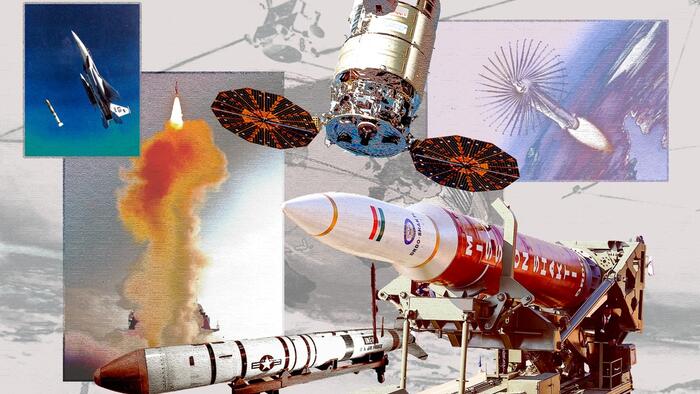Authored by Autumn Spredemann via The Epoch Times (emphasis ours),
Space has been called the final frontier and experts say governments are becoming more focused on strengthening defense and exploring the military potential of low Earth orbit.
Evan Ellis, an analyst and research professor for the U.S. Army War College, told The Epoch Times that expanding and protecting space infrastructure is becoming increasingly important from a national security perspective.
“It’s a recognition that space is important as a war-fighting domain, but also how you protect and use your assets in times of war,” Ellis said.
As a defense analyst, Ellis has participated in space war game scenarios. He says there are multiple kinds of weapons that can be used in Earth’s orbit. Some are kinetic such as missiles, but non-kinetic weapons such as electromagnetic pulses, micro-waves, and lasers are also possible.
He noted some are more practical in a space-to-space or space-to-Earth combat scenario than others. For example, lasers are less practical to have in a space-based platform since they would have energy supply and stability problems.
“If you want to penetrate someone’s [ground] bunker, then it makes more sense to use kinetic weapons than a laser from space,” Ellis said.
He said that targeting ground objects from space isn’t impossible, but it’s not a likely scenario. Instead, Ellis said it would be more pragmatic to hit other celestial targets.
“It makes sense to have things in space that can take out other things in space.”
National security lawyer and Scarab Rising president, Irina Tsukerman, said weapons don’t need to be put into space to be a threat to orbiting objects.
“Countries like China and Russia have developed various ASAT [anti-satellite weapon] capabilities, including kinetic kill vehicles and electronic warfare systems, aimed at disabling or destroying U.S. satellites,” Tsukerman told The Epoch Times via text.
Earth-based weapons with the ability to cripple or destroy satellites have existed for years. Yet with more countries investing in counter-space assets, worry over the possible use of ASATs as a wartime weapon is growing.
“While destructive ASATs have not yet been deployed in warfare, countries such as Russia, India, China, and the United States have demonstrated their ability to operate such weapons by destroying their own satellites,” a 2024 Atlantic Council analysis states.
“As countries’ reliance on space increases, the ability to hold other countries’ satellites at risk is a significant and concerning capability.”
Investment in space from a national security perspective also grew this year.
The Space Foundation reported that total global military space budgets increased 18 percent, representing 46 percent of total government space spending. The United States represents the majority of this at 80 percent, but countries like Japan and Poland have also drastically increased their space defense spending.
There’s widespread concern over the weaponization of space, especially given current geopolitical tensions between the United States, Russia, and China.
The United Nations’ Outer Space Treaty is a guardrail that has prohibited nuclear arms or weapons of mass destruction (WMDs) in orbit or on celestial bodies such as the moon since 1967. At the time of this report, the treaty has 115 parties and 89 signatories.
However, groups such as the Center for Arms Control and Non-Proliferation say increased militarization efforts in this domain already pose risks to national security.
The center identifies three classifications of space weaponry, including Earth-to-space, space-to-space, and space-to-Earth. Currently, due to restrictions outlined in the Outer Space Treaty, only Earth-to-space weapons have been developed in military arsenals. However, some say growing interest in the latter two categories makes expansion into these areas inevitable.
“Converging trends make the proliferation of space systems likely. The miniaturization of satellites combined with falling launch costs and the commercialization of the space industry means that more players are entering the space game—not all of whom will use space for peaceful purposes,” the Center for Arms Control and Non-Proliferation stated in a 2023 fact sheet.
The organization added that due to a lack of clear regulations and ambitious government regimes, militaries are already pushing the boundaries of acceptable space behavior.
“This could mean greater chances of conflict in the future as outer space is increasingly congested with dangerous capabilities,” the group said.
Within the three categories of space weaponry are four different types. The Center for Strategic and International Studies project Aerospace Security identifies these as kinetic physical, non-kinetic physical, electronic, and cyber.
The 2024 Secure World Foundation report noted, “The growing use of, and reliance on, space for national security has also led more countries to look at developing their own counter-space capabilities that can be used to deceive, disrupt, deny, degrade, or destroy space systems.”
This is underscored by a National Air and Space Intelligence Center report, which states, “Foreign competitors are integrating advanced space and counter-space technologies into warfighting strategies to challenge U.S. superiority and position themselves as space powers.”
Pentagon officials maintain that a competitive edge in space weaponry is necessary for the United States because evidence suggests that Russia is looking to do the same.
Read the rest here…
Loading…
Read the full article here

